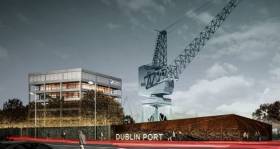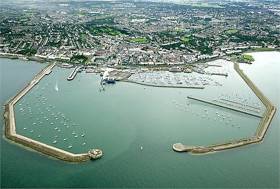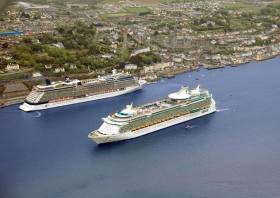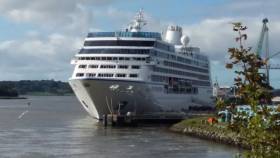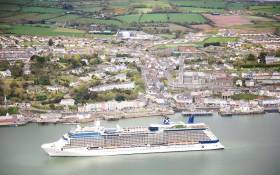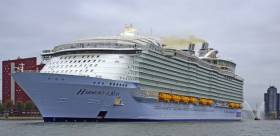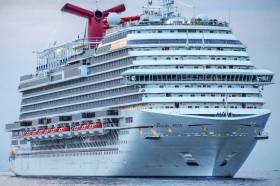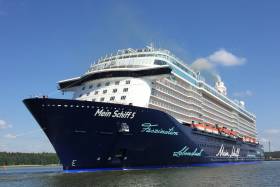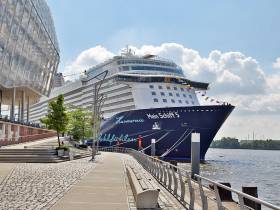Displaying items by tag: Cruise Liners
Plans By Dublin Port to ‘Reorder Area’ So to Open Up to City
#PortReOrder – Frank McDonald of the Irish Times writes about plans by Dublin Port to ‘soften the hard edge’ between its Port Centre and the still-developing north Docklands.
Dublin Port, for long a nearly enclosed semi-industrial estate at the eastern end of Docklands, is planning to open up to the city with an imaginative scheme to reorder the entire area around its own headquarters off East Wall Road.
Project manager Jim Kelleher, who was responsible for the outstanding Diving Bell restoration on Sir John Rogerson’s Quay, says the aim is to “soften the hard edge” between Port Centre and the still-developing north Docklands area.
Port Centre, designed by Scott Tallon Walker and completed in 1981, has been marooned behind a stone wall that extends all along the east side of the heavily trafficked East Wall Road, which is extremely hostile to pedestrians.
Standing six storeys high on a podium, the new building replaced the port’s old headquarters at the Ballast Office, on the corner of Aston Quay and Westmoreland Street, which in turn was demolished and replaced by a half-hearted “replica”.
An architectural competition in 2014 led to Darmody Architects winning the commission to create a significant public space around Port Centre, including removal of parts of the unlisted stone boundary wall dating from the 1880s.
Principal architect Tim Darmody says his scheme is “all about port-city integration”, with an impressive set of gates on East Wall Road leading to a plaza in front of the port company’s headquarters and a landscaped “garden” to the south of it.
A new boundary made from pre-rusted Corten steel panels will replace the late 19th-century stone wall at southern end of the two-acre site, with a relocated 10-tonne Stothert & Pitt crane, dating from the 1950s, rearing up above the new wall.
This dramatic installation will be “painted, illuminated, celebrated”, as Jim Kelleher says, as a totem for Dublin Port and its history, clearly visible to motorists driving north across the East Link Bridge towards the Port Tunnel and M50 motorway. To read much more of a separate but port related development proposed by Dublin City Council, click here.
Afloat.ie adds among the reasons for the proposed crane relocation is the Alexandra Basin Redevelopment (ABR) project.
There has been a conservation assessment of such structures within the ABR that includes the site where Dublin Graving Docks Ltd operated until closure earlier this year.
In addition Afloat.ie is to further examine the background of the crane in greater detail as it forms part of the capital's port maritime industrial heritage.
#Transfer - Minister for Transport has said in the Seanad the transfer of governance of Dún Laoghaire Harbour Company to the local council is imminent, writes The Irish Times.
Minister Shane Ross said he understood the company and Dún Laoghaire-Rathdown County Council had established transitional teams which were working on the practical issues associated with the transfer. (See: Regional Ports Transfer)
He said officials from his department had met both sides on a number of occasions to assist in the process. “I have also met with many local groups,’’ he added.
Mr Ross said the company faced a challenging financial and operating environment as it moved from commercial shipping activities towards a different operating model, with the focus on marine leisure and marine-related tourism.
Stena Line’s departure from Dún Laoghaire Harbour added to the future challenges to the company. “The financial impact on the port is significant and it is very clear that the company faces a very different operating environment than it faced in the past,’’ he said.
For more on the commercial future of the harbour, click here
As previously reported on Afloat.ie, a Public Meeting regarding the proposed giant cruise liner berth is scheduled today, Thursday 27 October at 7pm in the Royal Marine Hotel. Speakers including Richard Boyd Barrett TD and Cllr Melissa Halpin will outline the two main options for the Government as the SOS movement sees it.
No Single Port – Ireland Needs Them All for Cruise Ship Business
The cruise ship industry is a huge and growing business …. The “ship hotel” as it has been dubbed. There is huge competition amongst the companies which own the ships and amongst the ports which want them to call. More, bigger cruise ships than ever have been and are being built, with ever-bigger passenger capacity. The Cruise Line International Association Europe said last year that the contribution of Cruise Ship Tourism to the economies of Europe was worth €40 billion and accounted for nearly 350,000 European jobs and that Europe was the second biggest market worldwide, after the United States.
Ireland has been attracting plenty of cruise ship business. Last year 193 vessels called to Irish ports - Dublin and Cork being the main locations, followed by Waterford, with Dun Laoghaire, Killybegs, Foynes and Bantry Bay also calling-locations. That number of ships was an increase of 16 and the number of passengers was close to 250,000 – an increase of almost 40,000 - on the previous year. As dictated by Government policy, the ports are in competition with each other and the cruise ship business is one of their primary targets, though port administrations say that local businesses and the economy generally benefits more than they do from calls by cruise ships.
With more ships being built, many with bigger-than-ever passenger capacity, is the best approach for Ireland that its ports should be competing with each other for the business?
That’s the question I have been discussing on THIS ISLAND NATION Podcast this week, with a man in a position to see both sides, Capt. Michael McCarthy is Cork Port’s Commercial Manager and also Chairman of Cruise Europe. I talked to him in Cobh, as the town celebrated its latest international award for the handling of cruise ships.
• Listen to the Podcast below:
A Nautical Caller Marks Final South-East Seasonal Visit
#FinalCaller - Nautica became the final cruiseship caller of the season to visit the Port of Waterford, writes Jehan Ashmore.
Oceania Cruises which operates the cruiseship which has undergone a multimillion dolar refurbishment had berthed at Belview on Monday.
The facility 5kms downstream of Ireland's oldest city is the main terminal for the port, which launched last week a business plan looking forward to 2020.
The 30,000 tonnes ship had called with a capacity for 684 passengers. Accommodation consists of 342 luxurious suites and staterooms, nearly 70% of which feature private verandas.
Guests visited the attractions of the south-eastern region in which a total of 16 calls were made this season.
The cruiseships calling at Waterford Estuary asides using Belview, also docked at the city quays and at anchorage off Dunmore East.
Dublin Port Dredging Plans For Cruise Terminal Project Get Go-Ahead
#DublinPort - Planning permission has been granted for a major dredging scheme at Dublin Port, clearing the final hurdle before works on the proposed new cruise liner terminal for the city.
The application, given the go-ahead by the Environmental Protection Agency (EPA) on Tuesday 13 September, provides for dredging from the North Wall Quay Extension to the -10m Chart Datum contour in Dublin Bay.
It also permits the disposal of dredged material at the existing licensed site west of the Burford Bank – a matter of much controversy this summer due to its location within the special are of conservation from Rockabill to Dalkey Island.
The subsequent Alexandra Basin Redevelopment Project comprises the infilling of the basin at current berths 52 and 53, a deepening of the fairway and a marina protection structure, intended to future-proof the port to accommodate the next generation of cruise liners of more than 300m in length.
Dublin Port's plans advance as Dun Laoghaire awaits the next step in its own harbour masterplan proposals for a modern cruise terminal.
Cork's Cobh Listed in Top Three Destinations In Worldwide Cruise Critic Traveller Awards
#CobhAward – TripAdvisor which owns Cruise Critic, the world's largest cruise review site and online cruise community, has announced Cobh as among the winners of the inaugural Cruise Critic Cruisers’ Choice Destination Awards.
In the British Isles and Western Europe awards, Cork’s Cobh was ranked second place, Glasgow’s Greenock ranked third, leaving Amsterdam to top the list in first place, with calls to the Dutch destination from the likes of Regent Seven Seas and Azamara Club Cruises.
The awards name the best cruise destinations of the year – across 15 regions around the world – based entirely on reviews posted to the Cruise Critic website. All rankings are based on member review ratings for ports from sailings taken August 1, 2015 to July 31, 2016.
“A cruise isn’t just about the ship – picking the right itinerary is imperative,” explains Adam Coulter, UK editor, Cruise Critic. “Cruises enable travellers to explore a number of amazing destinations, offering culture, beauty and history. With such a variety of unique destinations to choose from, these awards aim to highlight, and celebrate, those rated highly by travellers to offer inspiration and guidance to cruise planners.”
Popular ports include the Caribbean’s St. Maarten, which receives visits from lines including P&O Cruises, Royal Caribbean and MSC Cruises, and Alaska’s Glacier Bay which is visited by a number of cruise lines including Norwegian Cruise Line and Holland America Line.
The British love the Baltics - UK travellers rated Baltic destinations in their top three, with Stockholm first, followed by Tallinn and Copenhagen.
Crewman Dies In Lifeboat Accident On World's Biggest Cruise Liner
#CruiseLiners - A crewman has died during a safety drill on the world's largest cruise liner in the Mediterranean, as AFP reports.
The Filipino was one of five crew members from the Harmony of the Seas who were on board one of the ship's lifeboats when it suddenly detached from the vessel and fell 10 metres into the water below.
Two others on the lifeboat were hospitalised in critical condition after the incident, which occurred after the 362m ocean liner arrived in the port of Marseille in southern France earlier today (Tuesday 13 September).
It's not yet known how the lifeboat came to detach from the cruise liner, which entered service this past May.
According to Mail Online, the ship was described as a 'floating construction site' on its inaugural voyage.
Passengers reported holes in floors and walls, and accident hazards such as cables, blowtorches and power tools left by contractors on the top deck.
Video Shows Destruction Of Pleasure Craft Berths By Turning Cruise Liner
#CruiseLiners - Millions of euros worth of damage has been inflicted at a marina on the island of Sicily by a 'mini-tsunami' caused by the engines of a manoeuvring cruise liner.
Video from Mail Online shows the moments when the enormous Carnival Vista swamped nearby pleasure craft berths as it turned at the port of Messina on 28 August last.
Onlookers from the 15-deck ocean liner described people running away from the pontoon area as it was first swamped and then quickly destroyed by the powerful wake generated by its turbo engines.
A number of boats in the marina, where mooring costs reach €27,000 annually, were seen capsizing and sinking as the Vista – which has its maiden voyage in May this year – pulled away from the harbour.
No injuries were reported after the incident, though it's believed the damaged caused totals multiple millions of euro.
Mail Online has more on the story HERE.
Winds of Change Channel New Cruiseship Call to Cobh Instead of Capital
#WindsofChange – Afloat.ie has monitored Mein Schiff 5 movements noting the new cruiseship less than two months in service was forced to change its first ever call to an Irish port today, writes Jehan Ashmore.
It transpired that high winds forecast at Dublin Port were the cause and so the 2,750 passenger cruiseship had to call to Cobh, where the 295m newbuild berthed this morning but was due to call anyway tomorrow. Cruisegoers will not be left dissappointed as the near 100,00 gross tonnage ship will be simply swapping ports with the scheduled call to the capital a day later.
The impact of windage on the TUI Cruises newest ship with 15 decks high had to be considered when berthing in the confines of Dublin Port, where most callers are to Alexandra Basin.
Dublin Port Company’s first ever cruise terminal costing €30m is part of the Alexandra Basin Redevelopment Project (ABR) which is been built to accommodate even larger cruiseships and following a major dredging channel campaign.
A reconfiguration of quays will enable these mega cruiseships to call using an increased turning circle though at the expense of demolishing the end of the North Wall Quay Extension.
More quayside space and adjacent hard standing for cargo space, however will be made with the infilling of the Dublin Graving Docks that closed in April.
The ABR project is phase one of DPC plans to also permit increasingly larger cargsoships and associated deeper drafts to enter the port, so to meet demands of throughput which is forecast to rise, as the port in 2015 alone experienced record breaking volumes.
The 220m graving dock is nearby to where these mega cruiseships will dock at the two-berth terminal and much closer to city-centre, been next to the Tom Clarke toll-bridge.
Come In Channel No.5 As Irish Ports Await Arrival of Another Big Brand New Cruiseship
#NewestShip – Afloat.ie has tracked another big brand new cruiseship, Mein Schiff 5 that is to make a first call to an Irish port tomorrow, reflecting the growing demand for such visits and related infrastructural developments, writes Jehan Ashmore.
Mein Schiff 5 towering 15 decks and almost 100,000 gross tonnage is TUI Cruises' latest fleet member with a 2,750 passenger capacity that is to make a debut to Dublin Port before dawn.
After her visit to the capital, passengers have no less than 13 restuarants and bistros dining options to choose, before it will be the Port of Cork’s turn to welcome the latest newcomer to Cobh on Saturday. Both Dublin through its new cruise terminal development and Cobh’s upgrade are to meet the berthing requirements of even much larger cruiseships.
Today, Mein Schiff is berthed at the Port of Holyhead from where had arrived from the UK’s premier cruise port of Southampton.
In July, the 295m vessel was named Mein Schiff 5 at a ceremony in Lübeck/Travemünde. It was at nearby Kiel, she sailed across the Baltic Sea for her maiden voyage to Stockholm, calling at Tallinn, St. Petersburg and Helsinki.
The newest addition brings to a total of 14 cruiseships for TUI Group, a hotel and cruise group that was initiated at the end of 2014 and includes the rebranding of the UK operator, Thomson Cruises. Mein Schiff 5 is the Group’s third new build, and in June was handed over 10 days ahead of scheduled at the Meyer Turku shipyard, Finland to subsidiary TUI Cruises.
Like TUI Cruises’ other newbuilds, Meins Schiff 5 is a low-vibration vessel, which uses state of the art technologically that will enhance a pleasant environment for her guests. She has a 280m jogging track and 25m swimming pool.
In terms of operational efficiency, there is 30% less energy consumption and therefore 30% less fuel than other cruiseships of a comparable size.
Towards the end of the construction period, work simultaneously began on the construction of another sister, Mein Schiff 6. Meyer Turku were also involved in the construction of predecessor, Mein Schiff 4 launched in 2014.
In the following year, Mein Schiff 4 made a first call to Dun Laoghaire with an anchorage much closer to the harbour compared to other callers of recent years. The south Dublin Bay port still awaits a planning decision on the controversial cruise-berth to enable such sized ships and even larger to dock within the harbour.


























